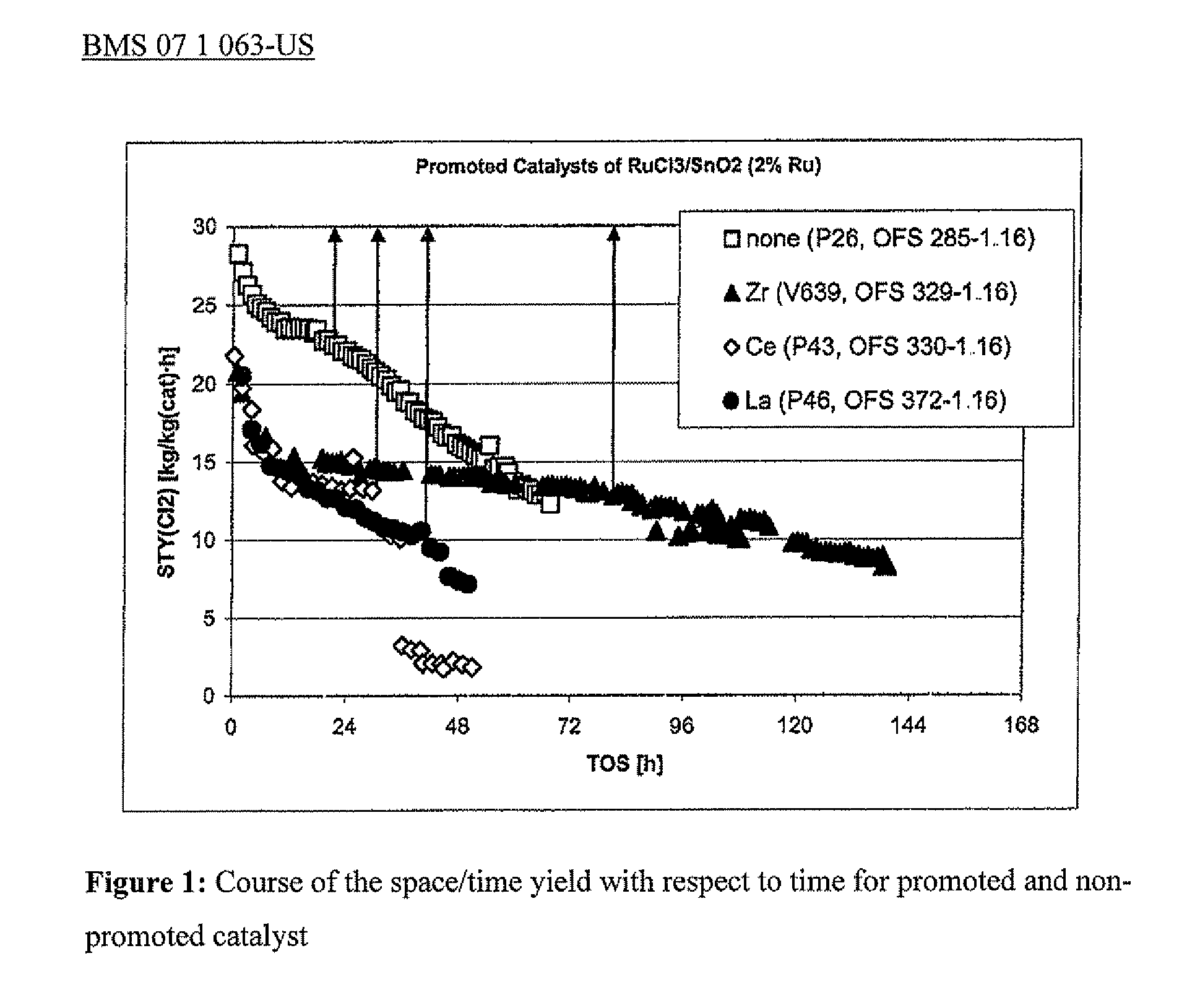Ruthenium catalysts having enhanced long-term stability and activity
a technology of ruthenium catalysts and long-term stability, which is applied in the field of ruthenium catalysts, can solve the problems of not disclosing the long-term stability of this catalys
- Summary
- Abstract
- Description
- Claims
- Application Information
AI Technical Summary
Problems solved by technology
Method used
Image
Examples
example 1
Zirconium-Promoted Catalyst
[0051]0.53 grams of ruthenium chloride n-hydrate and 0.048 grams of zirconium (IV) chloride were dissolved in 1.8 mL of water, to which 10 grams of support (SnO2 / Al2O3) (85:15 m / m); 1.5 mm) was then added and the components were mixed thoroughly until the solution had been absorbed by the support. The support impregnated in this way was left to stand for 1 hour. The moist solid was finally dried in the unwashed form in a muffle oven for 4 hours at 60° C. and 16 hours at 250° C.
[0052]0.2 grams of the dried catalyst was diluted with 0.5 grams of SiO2 (Saint Gobain; 1.5 mm), and a flow of 80 mL / min (STP) of oxygen and 160 mL / min (STP) of hydrogen chloride was passed through the catalyst at 540° C. The amount of chlorine formed was determined via introduction into a 16% strength potassium iodide solution and titration of the iodine formed with thiosulfate. The course of the space / time yield with respect to time shown in FIG. 1 resulted.
example 2
Cerium-Promoted Catalyst
[0053]0.53 grams of ruthenium chloride n-hydrate and 0.052 grams of cerium (III) chloride were dissolved in 1.8 mL of water, to which 10 grams of support (SnO2 / Al2O3) (85:15 m / m); 1.5 mm) was then added and the components were mixed thoroughly until the solution had been absorbed by the support. The support impregnated in this way was left to stand for 1 hour. The moist solid was finally dried in the unwashed form in a muffle oven for 4 hours at 60° C. and 16 hours at 250° C.
[0054]0.2 grams of the dried catalyst was diluted with 0.5 grams of SiO2 (Saint Gobain; 1.5 mm), and a flow of 80 mL / min (STP) of oxygen and 160 mL / min (STP) of hydrogen chloride was passed through the catalyst at 540° C. The amount of chlorine formed was determined via introduction into a 16% strength potassium iodide solution and titration of the iodine formed with thiosulfate. The course of the space / time yield with respect to time shown in FIG. 1 resulted.
example 3
Lanthanum-Promoted Catalyst
[0055]0.53 grams of ruthenium chloride n-hydrate and 0.079 grams of lanthanum (III) chloride heptahydrate were dissolved in 1.8 mL of water, to which 10 grams of support (SnO2 / Al2O3) (85:15 m / m); 1.5 mm) was then added and the components were mixed thoroughly until the solution had been absorbed by the support. The support impregnated in this way was left to stand for 1 hour. The moist solid was finally dried in the unwashed form in a muffle oven for 4 hours at 60° C. and 16 hours at 250° C.
[0056]0.2 grams of the dried catalyst was diluted with 0.5 grams of SiO2 (Saint Gobain; 1.5 mm), and a flow of 80 mL / min (STP) of oxygen and 160 mL / min (STP) of hydrogen chloride was passed through the catalyst at 540° C. The amount of chlorine formed was determined via introduction into a 16% strength potassium iodide solution and titration of the iodine formed with thiosulfate. The course of the space / time yield with respect to time shown in FIG. 1 resulted.
[0057]FIG....
PUM
| Property | Measurement | Unit |
|---|---|---|
| Temperature | aaaaa | aaaaa |
| Percent by mass | aaaaa | aaaaa |
| Pressure | aaaaa | aaaaa |
Abstract
Description
Claims
Application Information
 Login to view more
Login to view more - R&D Engineer
- R&D Manager
- IP Professional
- Industry Leading Data Capabilities
- Powerful AI technology
- Patent DNA Extraction
Browse by: Latest US Patents, China's latest patents, Technical Efficacy Thesaurus, Application Domain, Technology Topic.
© 2024 PatSnap. All rights reserved.Legal|Privacy policy|Modern Slavery Act Transparency Statement|Sitemap

